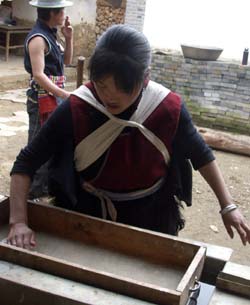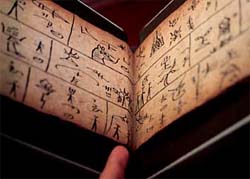

As one of the 55 ethnic groups in China, the Naxi people, with a population of 300,000, mostly live in mountainous communities in the Lijiang Naxi Autonomous County in southwest China's Yunnan Province. They created pictographic characters called the "Dongba" script about 1,000 years ago, and produced hand-made paper to record their beautiful folklore, legends, poems and religious classics. However, the technique is facing extinction nowadays for few people know the craft and not enough raw materials available for the products.
With the support from Chinese Academy Science (CAS) and the Netherlands-based Interchurch Organization for Development Co-operation (ICCO), a group of ethno-botanists headed by Prof. Xu Jianchu from the CAS Kunming Institute of Botany has carried out studies into the mechanism for the saving the legacy from dying out.
Being in the mountainous area at the northwest tip of the Yunnan Province, which is noted for its flourishing cultural and biological diversities, the Naxi culture is intimately related to their mountainous environment. Studies show that the hand-made Naxi paper is the outcome of a marriage between paper-making technique, which was introduced to Yunnan when Naxi ancestors settled in Lijiang, and rich plant resources in the vicinity. Researchers discovered that the paper, which is made of local plants containing a natural insect repellent, is favorable for the long-term preservation. As a result, more than 30,000 copies of Dongba manuscripts are survived and collected by libraries worldwide.
The experts believe that it is necessary to prevent the complete loss of the papermaking skill as a major medium for the Dongba culture by teaching the young generations the traditional technique of papermaking. However, the exhausting supply of the raw material for the paper will hinder the practice.
It is discovered that the Dongba paper is made from two endemic stringbush plants
Wikstroemia delavayi and
W. Lichiangensis, noted for its well-developed bast fiber. In the period from 1950s to 1970s, the bast of the plants was largely collected by industrialized papermaking mills outside the province. As a result, the local population of the plants has been reduced into shrubs or thickets as the total volume of the resources has been mostly devastated. Although some local people would like to pick up the technique, the practice is strict due to the reduction of domestic plants.
There exists a close interrelationship between the traditional culture of the ethnical communities and native taxa, says Prof. Xu Jianchu. A region with magnificent biodiversity often has tremendous ethnic and cultural diversity. The various natural settings and rich biological resources in the region could be not only material basis for the ethnical people to survive and make eco-social progress, but also for their evolution and cultural development. When traditional culture declines, the local biodiversity will be under threat, and
vice versa.
In order to protect and develop the ethnical culture, the scientists made following suggestions. First, the intellectual property rights of the ethnic technique should be fully recognized and protected. In this way, the paper-making technique may survive under the all-sweeping impact of the modern civilization.
Second, a full play will be given to the market level. Marketing mechanism might be introduced to transform the Naxi paper's sole function of cultural heritage as the Dongba scripture to communities as souvenirs.
Third, efforts are to be made for sustainable development of the local plant resources. With the support of the project, local people have succeeded in breeding the fibrous plants with cuttage and seeds in their experimental plots. In the current context of returning the reclaimed farmlands into their original state of forests and grasslands, it is expected that the raw material crisis in the traditional paper-making technique might be mitigated in coming years.






